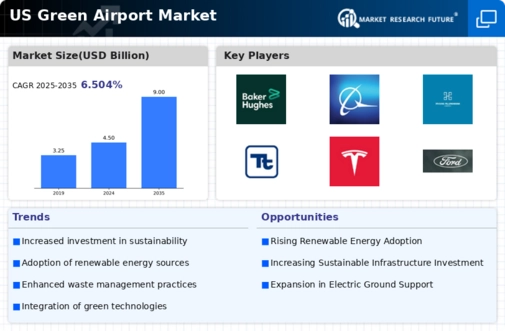The green airport market is currently characterized by a dynamic competitive landscape, driven by increasing regulatory pressures and a growing emphasis on sustainability. Key players are actively pursuing innovative strategies to enhance operational efficiency and reduce carbon footprints. Companies such as Boeing (US), Honeywell (US), and Lockheed Martin (US) are at the forefront, focusing on technological advancements and strategic partnerships to solidify their market positions. Boeing (US) has been particularly proactive in integrating sustainable aviation technologies, while Honeywell (US) emphasizes smart airport solutions that enhance energy efficiency. Lockheed Martin (US) is leveraging its expertise in defense and aerospace to develop eco-friendly airport infrastructure, indicating a trend towards cross-industry collaboration that shapes the competitive environment.
In terms of business tactics, companies are increasingly localizing manufacturing and optimizing supply chains to enhance resilience and sustainability. The market appears moderately fragmented, with several players vying for dominance. However, the collective influence of major companies is significant, as they drive innovation and set industry standards. This competitive structure fosters an environment where collaboration and strategic alliances are essential for success, allowing companies to pool resources and share expertise in green technologies.
In November 2025, Boeing (US) announced a partnership with a leading renewable energy firm to develop solar-powered airport facilities. This strategic move is likely to enhance Boeing's portfolio in sustainable aviation solutions, positioning the company as a leader in the transition towards greener airport operations. The collaboration underscores the importance of integrating renewable energy sources into airport infrastructure, which could significantly reduce operational costs and carbon emissions.
In October 2025, Honeywell (US) launched a new suite of smart airport technologies designed to optimize energy consumption and improve passenger experience. This initiative reflects Honeywell's commitment to digital transformation and sustainability, suggesting that the company is keen on leveraging data analytics and IoT to create more efficient airport environments. Such advancements may not only enhance operational efficiency but also attract environmentally conscious airlines and travelers.
In September 2025, Lockheed Martin (US) unveiled a new eco-friendly airport design concept that incorporates advanced materials and energy-efficient systems. This initiative indicates Lockheed Martin's strategic focus on innovation in airport infrastructure, potentially setting new benchmarks for sustainability in the industry. The emphasis on cutting-edge design and technology may provide Lockheed Martin with a competitive edge as airports increasingly seek to modernize their facilities in line with environmental standards.
As of December 2025, the competitive trends in the green airport market are heavily influenced by digitalization, sustainability, and the integration of AI technologies. Strategic alliances are becoming increasingly vital, as companies recognize the need to collaborate in order to innovate and meet regulatory demands. The shift from price-based competition to a focus on technological advancement and supply chain reliability is evident, suggesting that future competitive differentiation will hinge on the ability to innovate and adapt to evolving market conditions.






















Leave a Comment